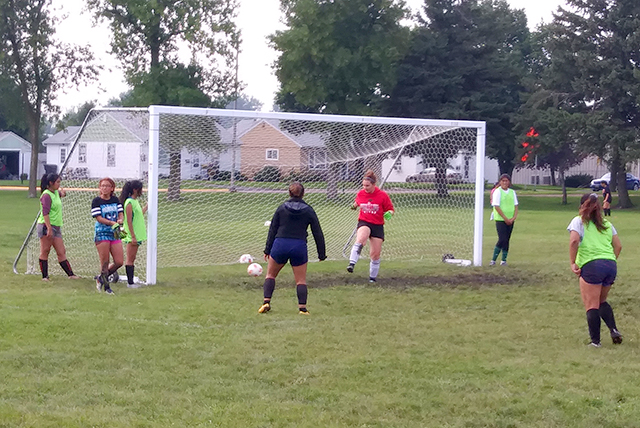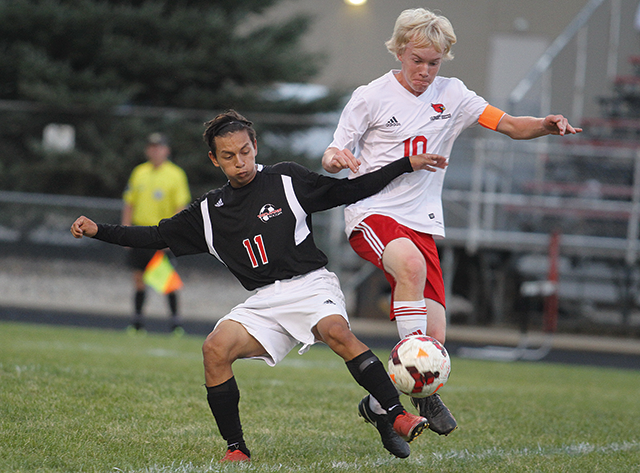On a field outside of Worthington High School, a teenager who just came back from Guatemala for the summer asks the school district’s activities director, Josh Dale, if he can join the boys soccer team, which is gearing up for practice.
Dale gives him the rundown — he must first fill out paperwork before participating — while head coach Juan Flores tells the kid, in Spanish, to come back the next day to begin the process.
Practice is still on for this late-summer weekday afternoon, despite barely escaping a rainstorm that passed through this southern Minnesota city of 13,000 people in the last few hours. Nearly 60 teenage boys are already here, stretching and getting ready to begin. The school’s girls soccer team, of which about 50 students showed up for today, is wrapping up its practice.
Of all of the students on the field, just a sliver of them — less than half a dozen — identify as white. The vast majority are Latino, while students of Laotian, African and African-American ethnicities also make up a sizable portion.
For Greater Minnesota, this kind of racial makeup is increasingly becoming the norm. Though Worthington’s rapid pace of change may be more dramatic than most places’ — the city saw a big influx of immigrants over the past few decades thanks largely to available jobs at a nearby meatpacking plant — more and more school districts outside of the Twin Cities have become majority-minority. The state projects Minnesota’s non-white population will grow by more than half a million people over the next two decades.
As these demographic changes transform the student makeup of many classrooms around the state, they have also impacted the state’s high school sports scene.
Flores, who graduated from this same high school roughly a decade ago, said he’s watched Worthington transform from a town “that’s never really heard of soccer” to one where the sport is now a key part of its identity.
“It’s becoming a culture here,” he said.

[image_credit]MinnPost photo by Joey Peters[/image_credit][image_caption]Part of what makes both soccer teams popular is Worthington’s policy of not cutting students from its teams, a practice that Josh Dale, above, said many other schools don’t follow.[/image_caption]
But in Worthington, Flores points to the town’s diversity — more than two-thirds of the city’s school district is made up of students of color — as the chief factor for explaining soccer’s recent popularity here.
Other school districts across the state are also seeing a similar phenomenon. In nearby Marshall, Bruce Remme, activities director of the local high school, said he’s seen “rapid increases” in student participation in soccer that “mirror the changing demographics of our school district.” Likewise, in St. Cloud, a mostly non-white boys soccer team won Apollo High School a state championship in 2014.
As this has happened, sports like golf and gymnastics have seen slight drops in popularity since the start of the decade. “Some of those specialized sports that you need to start at three or four years old, we’ve seen some decline in that,” said Dave Langerud, the former activities director at Apollo High School who now holds the same position at St. Cloud Tech. This is also true statewide, according to numbers again from the National Federation of State High School Associations.

[image_credit]Aaron Hagen/The Globe[/image_credit][image_caption]As a pair of Fairmont players come up to challenge, Worthington's Jon Keodouangsy, right, keeps his eye on the ball during the Sept. 24 match. The Trojans won the game, 1-0.[/image_caption]Everybody loves a winner
One factor helping the recent growth of certain sports is Minnesota’s long-existing culture of high-participation levels in high school athletics. More than half of all Minnesota high school boys are active in school sports, and the state now leads the country in girls high school sports participation, at 49 percent.
It’s a point of pride for Mike Beck, who works as a coordinator with the Minnesota Interscholastic Activities Administrators Association. “The people that run the programs in high schools here are competitive with each other,” he said. “They don’t just sit there and wait for kids to show up at their door.”
Oliver Ortiz and Abraham Atu both play on Worthington’s soccer team. Like so many of their peers, their parents originally came from countries where soccer is wildly popular.
Ortiz, who is 15, started playing the sport as a little boy. At home, his dad and stepmom, who came to the U.S. from Guatemala and Mexico respectively, watch and cheer for Team Mexico whenever the World Cup occurs. Atu, a 17-year-old junior, was first taught how to play the game by his mother, who came here from Ethiopia. They watch Real Madrid and Barcelona during soccer season and Mexico and Ethiopia during the World Cup.
Both point to diversity as well as other factors weighing into their team’s popularity in Worthington, including perhaps the most obvious one: the team wins. For the last two years, the Worthington boys soccer team won the Big South Conference, where they compete with 12 other nearby school districts. Last year, the boys team made it to the state tournament, and they are currently 13-2-0 and ranked No. 8 in the state in class 1A, the division for the Minnesota’s smaller schools.

[image_caption]Carlos Rodriguez[/image_caption]
Carlos Rodriguez, a volunteer coach whose daughter plays on the Worthington girls soccer team, cites the emergence of professional soccer in the U.S. as a factor in explaining the sport’s growing buzz. “You see MLS growing, so it was going to happen,” Rodriguez said. “A lot of kids want the challenge to join the MLS or the North American Soccer League.”
Worthington’s girls soccer team is also growing in popularity, though it’s less-established than the boys team. Last year, the girls varsity team didn’t win a single game during the season. (They’re 2-11-2 so far in 2018.)
Anne Raetz, an assistant varsity coach and junior varsity head coach for the girls’ team, attributed this in part to the fact that the city did not have a girls youth soccer team that plays during the offseason until earlier this year. She helped establish the youth team, which now meets during the spring, through the local YMCA. Such experience is crucial for the development of young players who first learn to play the sport in their backyards with their family, she said.
“Most of those girls had never played on an organized team before,” Raetz said. “So for us to try to be competitive with towns who have organized teams since they were in fourth, fifth grade, we don’t see ourselves equally matched because we’re still learning that team feel and how to function as a team.”
Last year’s poor performance hasn’t discouraged girls from participating, though, and the team’s racial makeup and background is similar to the boys. Freshman Janelle Rodriguez, for example, first learned to play soccer from her dad, who is originally from Honduras. Some students join the team because they didn’t have much else to do, as is the case for junior Elisa Lopez, who said she’s ready to get the season underway and move on from last year. “We didn’t do good last year, but I feel like this year could be our year,” Lopez said.
Making sports more accessible
When Emily Ahlquist, head coach of the girls varsity soccer team, began coaching at Worthington High School 10 years ago, the team’s players were mostly white. At the time, participation in soccer was not as big, as the team was just starting out and more girls were interested in sports like volleyball.
But today, Ahlquist said she has “one, maybe two” white girls on the team, which has changed its culture — for the better, she said. Family commitments like babysitting younger siblings can interfere with practice, she said, and coaches like her have had to adjust balancing between the two. “My whole approach to coaching is teaching them how to be not just soccer players but team players,” Ahlquist said.

[image_credit]MinnPost photo by Joey Peters[/image_credit][image_caption]Worthington’s girls soccer team is also growing in popularity.[/image_caption]
Another move that has helped participation: Worthington cut student activity fees from $100 to $60. And for students who meet free and reduced lunch guidelines — which accounts for nearly two-thirds of the high school’s student population and 70 percent of the district — the district cut the fee from $60 to $30.
And if students still can’t afford the fees, there are other options. This may include being assigned to hold the chains or running the score clock during football games. The school district, Dale said, wants as many students to participate but also wants them “to understand that things aren’t just going to be handed to them.”
“We know a lot of students are paying their own way,” he said.
The St. Cloud School District Area made similar drops in student fees in recent years. Langerud and his counterpart at St. Cloud Apollo, Justin Skaalerud, say they find a way to get interested students to participate regardless of whether they can afford it or not. “Justin and I have paid out of our own pockets,” Langerud said.
Last year, Apollo High School made statewide news for its efforts to accommodate Muslim girls who wanted to participate on the school’s swim team. Langerud, who served as athletic director at Apollo until this school year, said that it was hard for Muslim girls who wanted to swim to participate in the sport because of a religious requirement for clothing that covers their elbows and knees.
After the swim team coach helped two Muslim girls find swimwear that would adhere to those requirements, Langerud worked on getting a waiver for the gear from the Minnesota State High School League. Then, in a move of solidarity, the girls’ teammates “went and got the same type of swimsuits, so there was no difference between them, other than wearing a hijab,” Langerud said.
Langerud also worked on gaining the trust from Muslim families and community, meeting with local clerics and leaders every Saturday. They took a field trip with parents to the University of Minnesota to watch a fashion show featuring religiously appropriate athletic clothes. “It’s just about us being patient, respectful and trying out new things,” he said.






This is so encouraging. Best part is teaching our young people how to be a team players. This is important for life, not just athletics.
Yes, and providing such inclusive participation (e.g. playing fees, members never cut from the team) for all students should serve as a model for all Minnesota schools. Rah Rah Worthington!